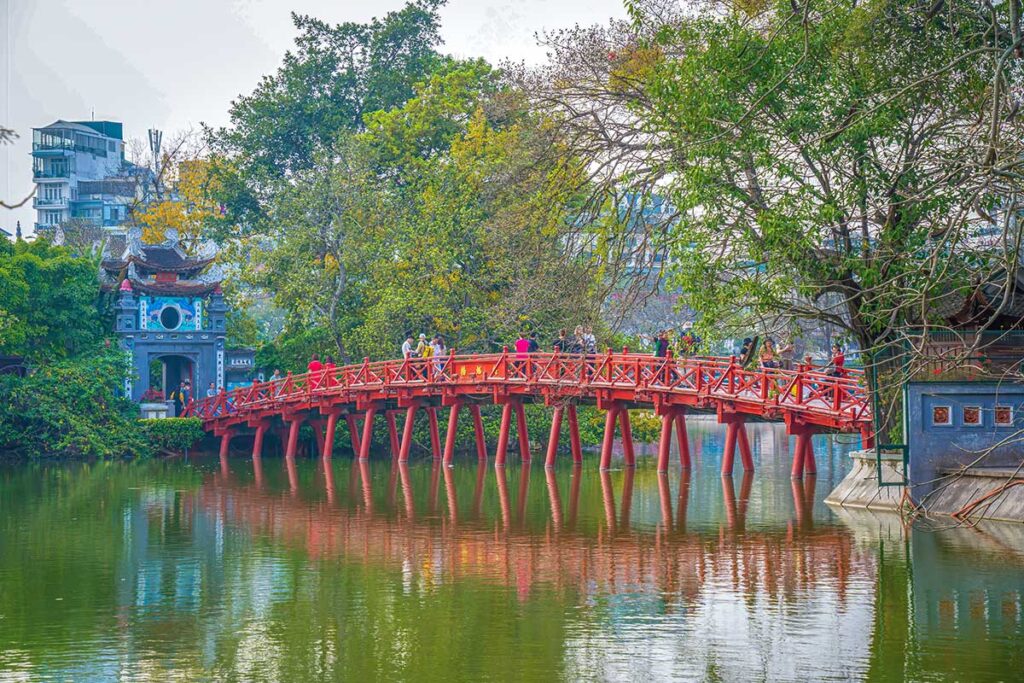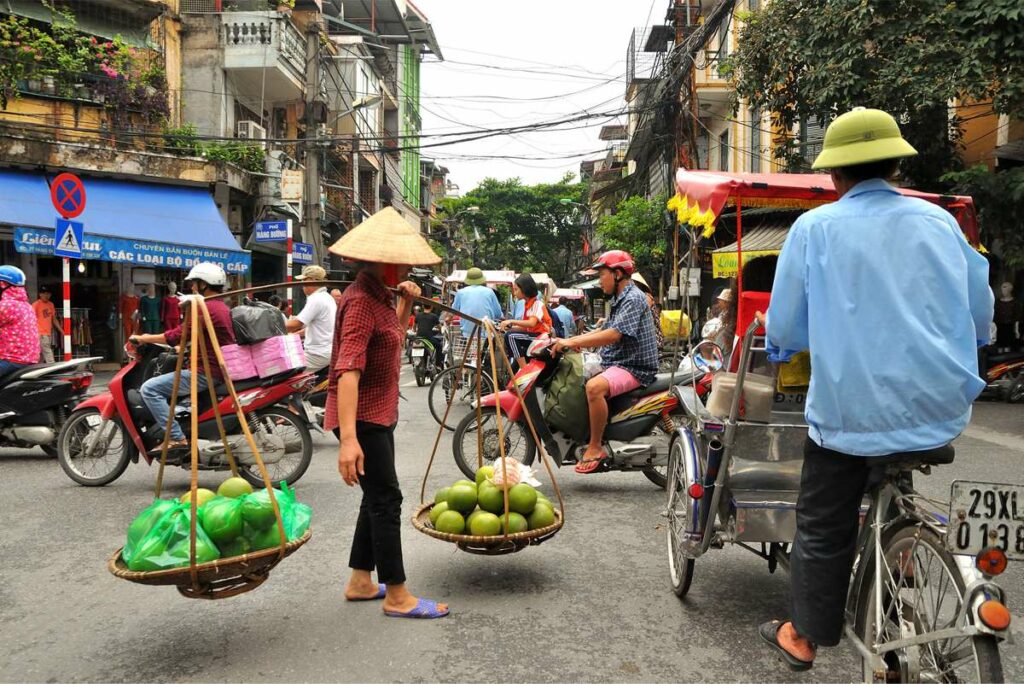What is The Huc Bridge in Hanoi?
The Huc Bridge is a small but striking red footbridge located on Hoan Kiem Lake, right in the heart of Hanoi’s Old Quarter. It connects the lakeside with Jade Island, where Ngoc Son Temple stands.
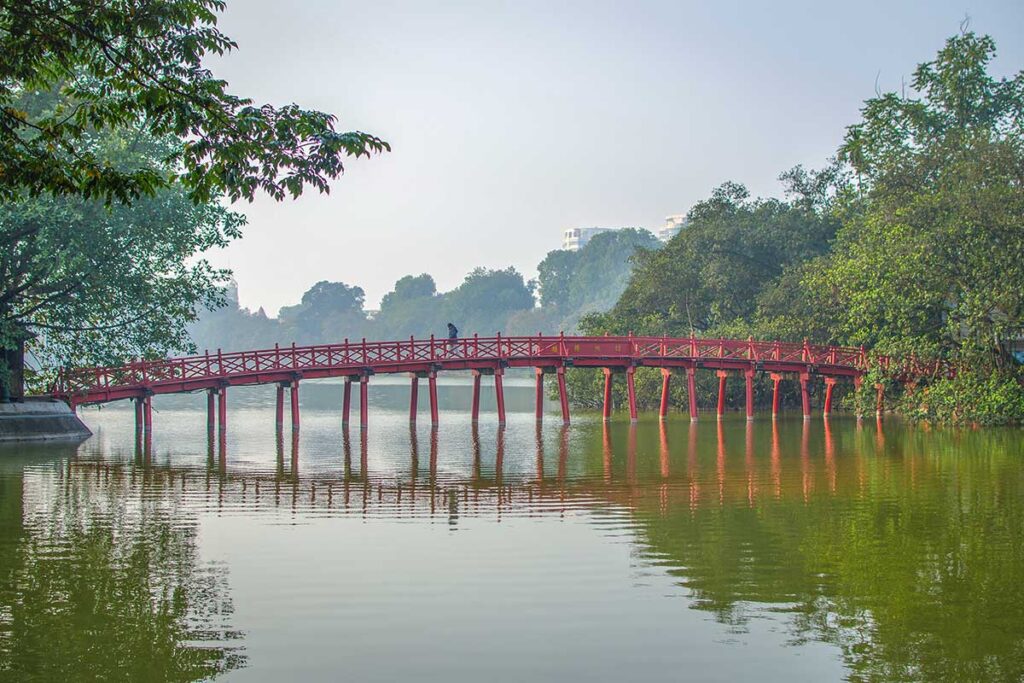
Today, the bridge is less about practical use and more about symbolism and sightseeing. It’s one of the most photographed spots in Hanoi, especially because of its vivid red color contrasting with the green water of the lake. Whether you’re crossing it to reach the temple or simply admiring it from the lakeshore, it’s a landmark that most visitors to Hanoi end up seeing—by day, at sunset, or beautifully lit at night.
History of The Huc Bridge
The Huc Bridge was first built in 1865 during the reign of Emperor Tự Đức. It was commissioned by scholar Nguyễn Văn Siêu, who was responsible for restoring Ngoc Son Temple on Jade Island. He gave the bridge its name, “Thê Húc,” which translates as “the rising and perching sun,” symbolizing light, vitality, and the welcoming of a new day.
Over the years, the bridge has not always stood unchanged. It was rebuilt in 1897 during the Thành Thái era, and again in 1953 after collapsing on New Year’s Eve in 1952 due to overcrowding. During this last reconstruction, its foundations were reinforced with cement for strength, though the wooden surface and traditional design were kept.
The bridge also played a role in colonial history. In 1887, two young Vietnamese students attempted to set it on fire in protest against the French, who had taken over Ngoc Son Temple. Their act of resistance ultimately led to harsh consequences, but it showed how deeply the bridge was tied to local identity and symbolism.
Another unique detail is that the bridge was photographed as early as the 1880s by Charles-Édouard Hocquard, making it one of the earliest visual records of Hanoi’s heritage. Its east-facing orientation, designed to catch the first rays of the morning sun, continues to reflect its original spiritual meaning.
Architecture of The Huc Bridge
The Huc Bridge is not a large structure, but its design is elegant and symbolic. It stretches across Hoan Kiem Lake with 15 spans supported by 32 wooden pillars arranged in 16 pairs. The bridge surface and railings are made of wood, painted in a deep red that immediately stands out against the green water of the lake.
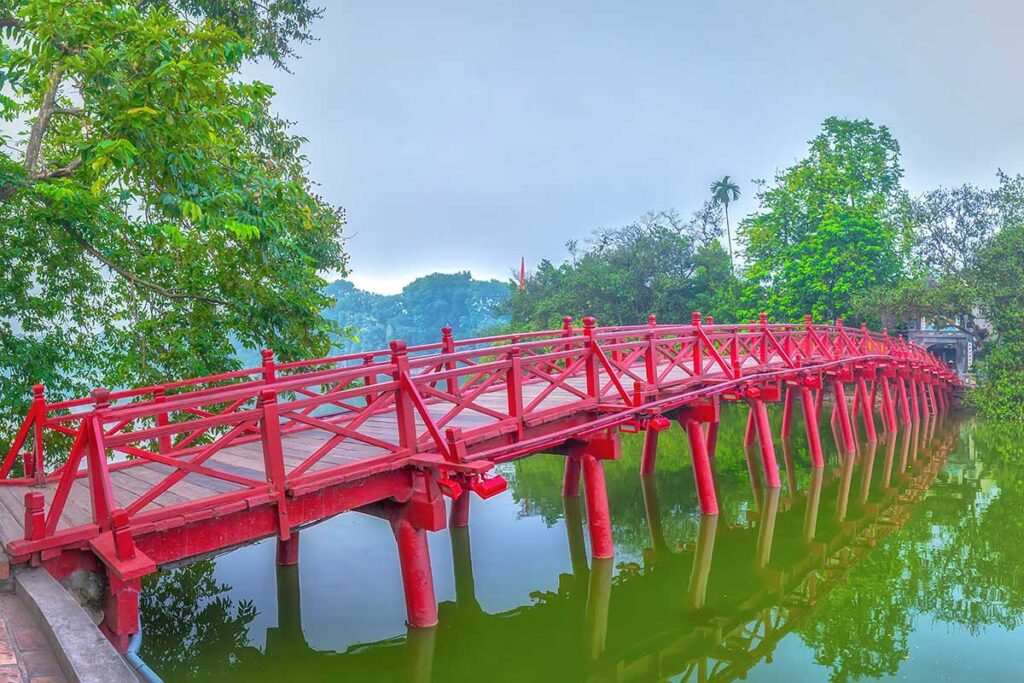
The railings are built in a traditional cross-pattern, giving the bridge both strength and visual harmony. Along the sides, you’ll find the inscription “Thê Húc” gilded in gold, reinforcing its name and meaning. The design is said to draw inspiration from traditional wooden houses in northern Vietnam, built with interlocking joints rather than nails.
While the current version was reinforced with cement foundations after its 1952 collapse, the bridge has retained its wooden deck and iconic red color. The east-facing curve is intentional—welcoming the sunrise each day, in line with its symbolic name. The red color itself also carries meaning in Vietnamese culture, representing life, good fortune, and happiness.
Highlights of visiting The Huc Bridge
1. Seeing it from the lakeshore
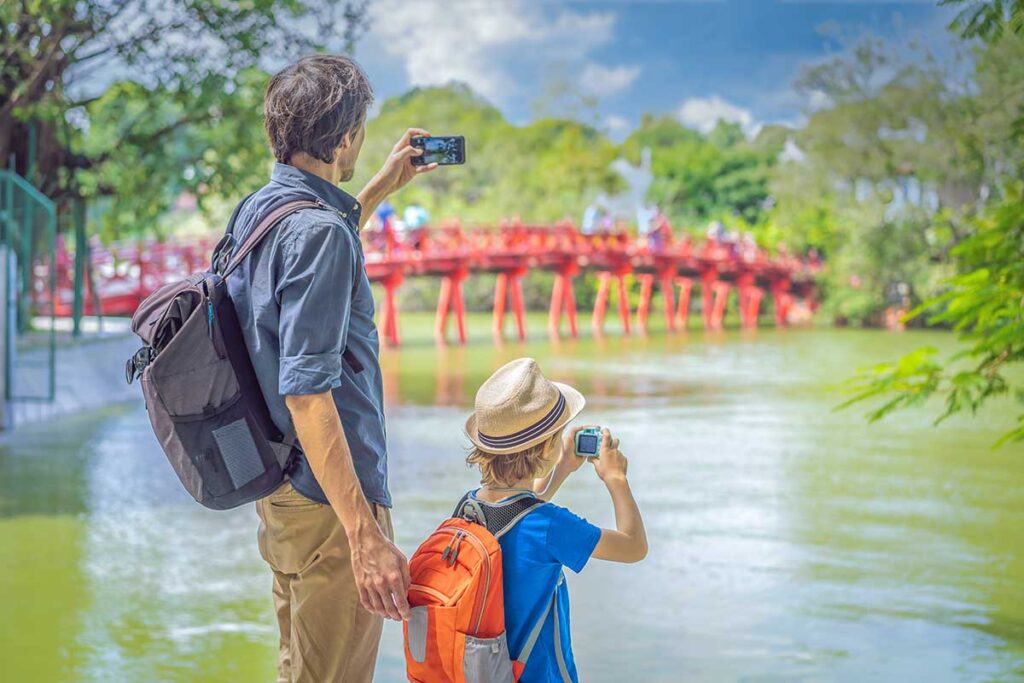
You don’t have to cross The Huc Bridge to enjoy it. From the walking paths around Hoan Kiem Lake, the bridge stands out as a striking red curve over the water. On clear days, its reflection creates some of the best photo opportunities in the Old Quarter.
2. Walking across the bridge
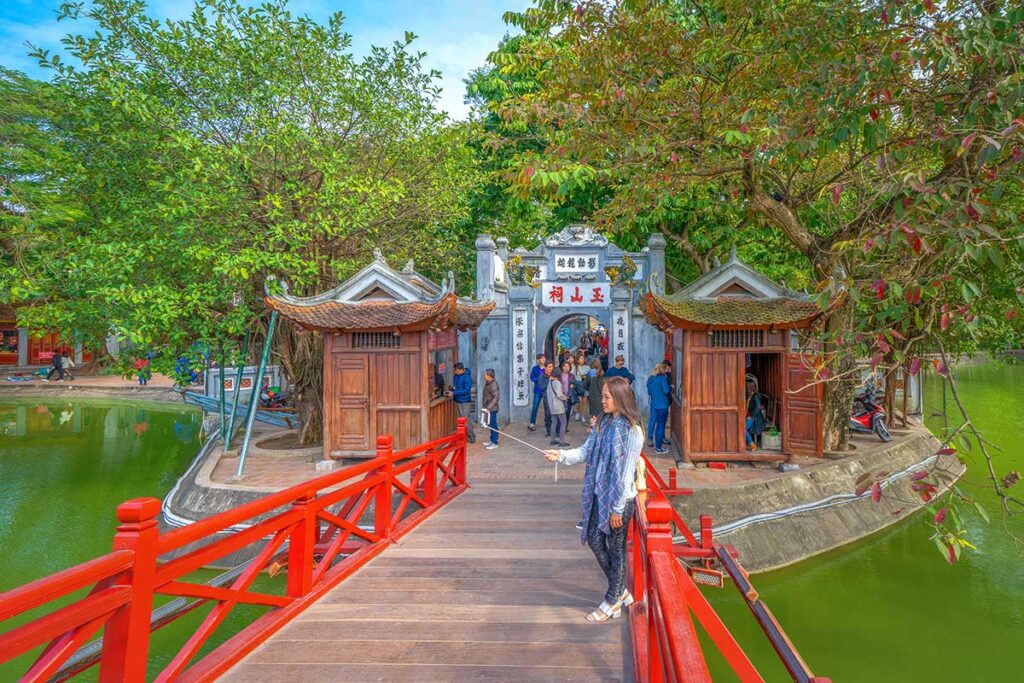
Crossing the bridge is the only way to reach Ngoc Son Temple on Jade Island. The walk is short, but it feels meaningful thanks to the color, history, and setting on the lake. Keep in mind that you’ll need a temple ticket to enter—the bridge itself is part of the paid complex.
3. Nighttime views
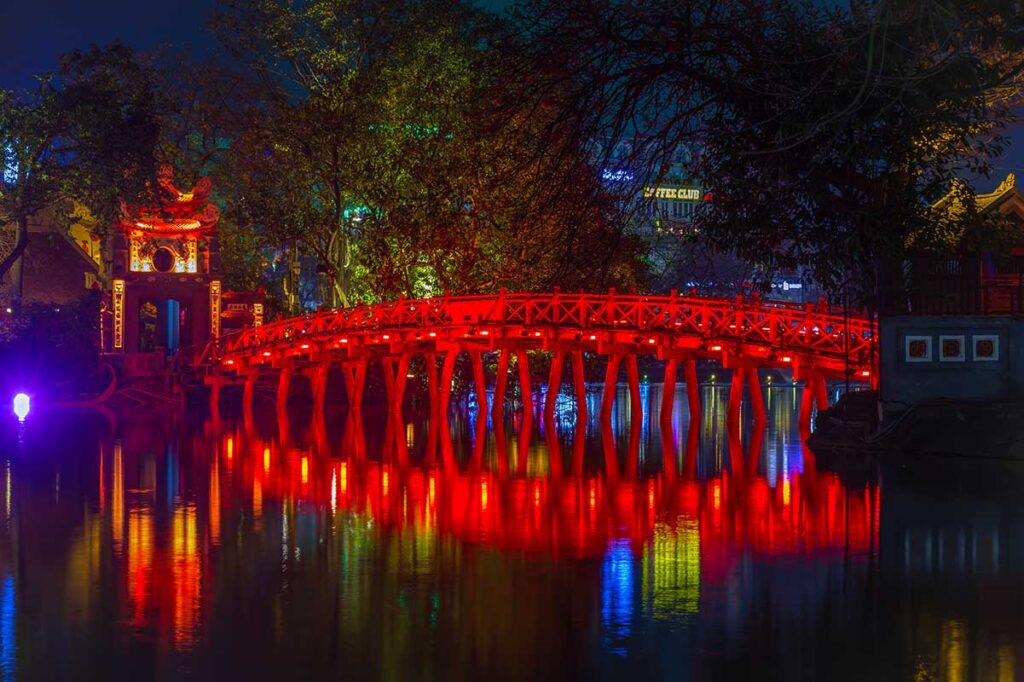
At night, The Huc Bridge is lit up in red and reflected across the dark surface of Hoan Kiem Lake. This is one of the most photographed sights in Hanoi, and even if you don’t plan to visit the temple, it’s worth strolling by after sunset to see it illuminated.
4. Sunrise and morning light
Facing east, the bridge catches the first light of the day. Early mornings are peaceful, with fewer people around and a calm atmosphere compared to the busy evenings. If you like photography or simply want to see Hanoi wake up, this is the best time to visit.
5. Connection to Ngoc Son Temple
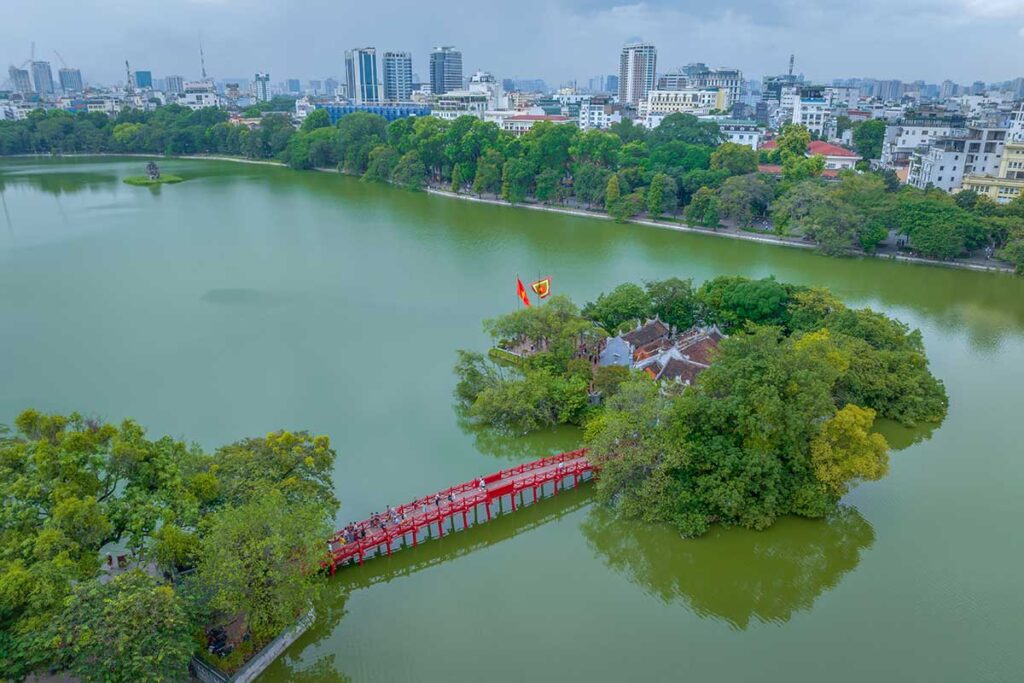
The bridge is not a standalone attraction—it’s the entryway to Ngoc Son Temple. Visiting the temple adds cultural and spiritual context, with shrines, legends, and views across the lake. Together, the bridge and temple form one of Hanoi’s most symbolic landmarks.
If you’d like to dive deeper into the temple itself, see our detailed Ngoc Son Temple guide.
Practical visitor information
Opening hours
You can see The Huc Bridge anytime from the paths around Hoan Kiem Lake, which are always open. However, to walk across the bridge and enter Ngoc Son Temple, you’ll need to follow temple hours: 7:00 AM – 6:00 PM daily.
Entrance fee
Crossing the bridge is included in the Ngoc Son Temple ticket, which costs 50,000 VND per adult. Tickets are sold at the booth near the main gate.
Best time to visit
The experience at The Huc Bridge changes a lot depending on when you go:
- Early morning – the area is quieter and less crowded, making it easier to enjoy the walk across the bridge. The light is softer, which makes the lake and the bridge look especially pleasant in photos.
- Late afternoon & evening – this is when the bridge feels most lively. You can watch the colors of the sunset over the lake and then see the bridge lit up at night, which many visitors find magical.
- Weekends – the streets around Hoan Kiem Lake are closed to traffic and turn into a pedestrian zone. It’s a fun atmosphere with music and families out walking, but the bridge itself can feel packed.
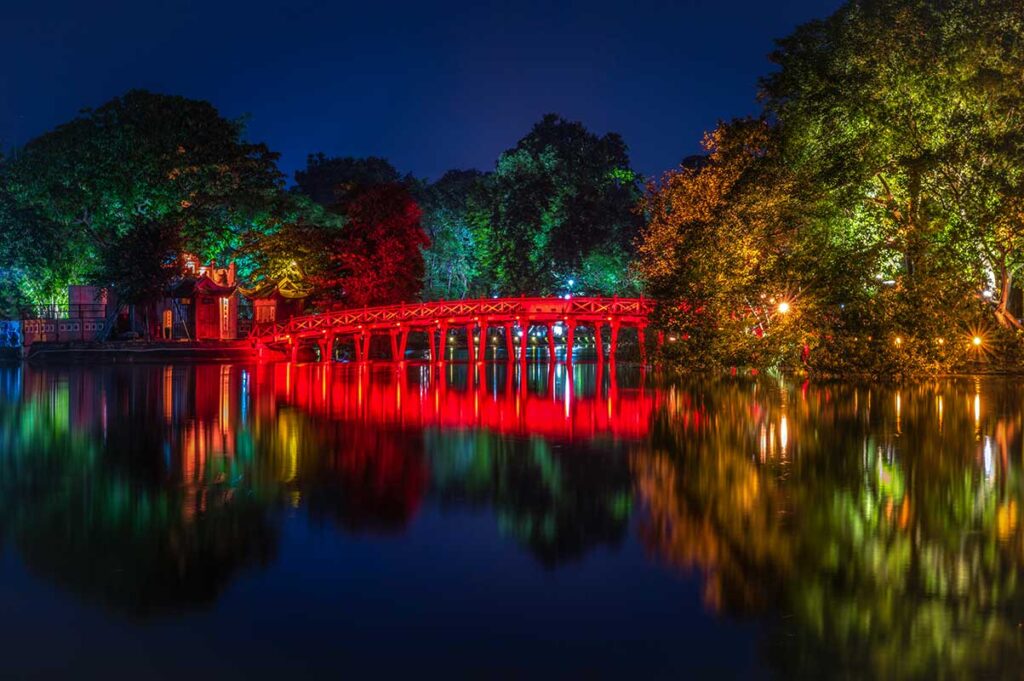
Getting there
The Huc Bridge is located right in the Old Quarter, so if you’re staying nearby, the easiest way is simply to walk. From further away, you can take a taxi or Grab (Vietnam’s ride-hailing app). Be aware that cars are not allowed around the lake on weekends, so you may need to walk a few minutes from the drop-off point.
Other sights nearby
The bridge is part of the Hoan Kiem Lake area, which is surrounded by some of Hanoi’s most famous landmarks. Combine your visit with:
- Hoan Kiem Lake walk – a loop around the lake is less than 2 km and offers changing perspectives of the bridge.
- Old Quarter – bustling streets just steps away, filled with shops, cafés, and local food.
- French Quarter – south of the lake, with colonial architecture, the Opera House, and Book Street.
- Turtle Tower – the small tower in the middle of the lake, often photographed with the bridge.
- Thang Long Water Puppet Theater – located at the edge of the lake, a short walk from the bridge.
Is The Huc Bridge worth visiting?
The Huc Bridge is small and doesn’t take long to see, but it has become one of Hanoi’s most recognizable landmarks. Its bright red color and symbolic link to Ngoc Son Temple make it more than just a walkway—it’s part of the city’s cultural identity.
On its own, the bridge won’t fill much of your itinerary, but as part of a visit to Ngoc Son Temple and a walk around Hoan Kiem Lake, it’s definitely worthwhile. Many visitors find it most memorable in the early morning when it’s quiet, or in the evening when it’s illuminated over the lake.
